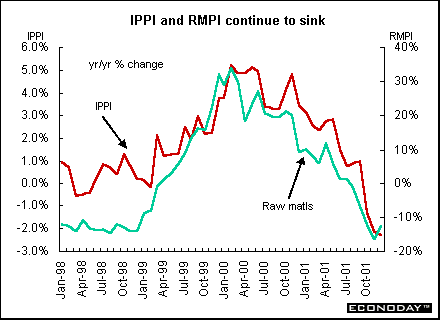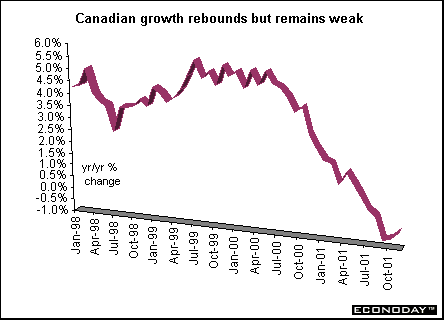
Indicator scoreboard
EMU - December M3 money supply growth rate was 8.0 percent, the same as in November. The three-month moving average for October through December rose to 7.8 percent when compared with the same months a year earlier. The three-month moving average increase is more than three percentage points above the ECB's 4.5 percent M3 growth reference rate for this year. Both of the headline M3 growth rates were the highest recorded since the start of European Monetary Union in January 1999. A breakdown of the M3 components makes clear that money supply growth rose again in large part due to portfolio shifts into the more liquid assets included in the broad monetary aggregate.

The seasonally adjusted Reuters purchasing managers index rose to 46.2 in January from 44.1 in December. The index hit a record low in October. An index level below 50 means that the sector contracted; the further the index below 50, the faster the contraction. The production sub-index rose to 47.9 from 45.2 in December, while new orders rose to an eight-month high of 46.9 from 43.7.

January flash harmonized index of consumer prices rose 0.4 percent and 2.5 percent when compared with last year. This is above the European Central Bank's 2 percent price stability limit. The increase was due to seasonal factors, tax increases and the introduction of euro notes and coins.
Germany - January Ifo Institute's west German business sentiment index rose to 86.3 from 85.8 in December. Both current conditions and business expectations rose. Until now, Ifo has released its business sentiment index, based on survey responses from 7,000 companies, with a time lag of one month. The EU requested more timely data for harmonized statistics gathering among its members and the Ifo complied starting with this release. Current conditions posted a slight rise to 78.0 in January compared to extrapolated December data of 77.6. Business expectations rose to 94.8 in January from 94.3 in December.

France - December producer prices declined 0.3 percent and 1.6 percent when compared with last year. A further drop in energy prices offset higher food industry prices. Excluding food and energy, the PPI slipped 0.1 percent but was up 0.4 percent on the year.
December unemployment rate remained at 9.0 percent. However, the number of unemployed rose for the sixth straight month by 6,000. Since June, unemployment has climbed by 136,000 to 2.405 million, according to the ILO definition which excludes jobseekers who did any work during the month.

Italy - December producer prices were down 0.1 percent and 1.3 percent when compared with last year. The drop was due mainly to lower oil product prices. Excluding energy, the PPI was unchanged and rose 0.5 percent on the year. Intermediate goods were down 0.3 percent on the month and 3.8 percent on the year. Consumer goods edged up 0.1 percent and rose 2.0 percent on the year.
Britain - January Nationwide house price index rose 0.2 percent following a 1.9 percent gain in December. They were up 11.7 percent on levels of a year earlier. Nationwide said that low mortgage rates were offsetting worries of job insecurity.

Asia
Japan - December retail sales fell 3.1 percent. Sales at large retailers, which account for about 15 percent of total spending, fell 7.4 percent, the biggest decline since April 1997. For the year 2001, retail sales fell 2.2 percent for a record fifth straight year.
December unemployment rate climbed to a record 5.6 percent from November's 5.5 percent. There were 51 jobs on offer last month for every 100 applicants at government-run work centers - or two applicants for every job - down from 53 jobs per 100 in November. Manufacturers, which employ about a fifth of Japanese workers, cut 120,000 jobs. In the construction industry, which employs almost one in 10 workers, 170,000 jobs disappeared. Another 150,000 jobs at restaurants, retailers and wholesalers were lost.

December seasonally adjusted spending by households headed by salaried workers tumbled 6.9 percent. Spending fell 4.4 percent when compared with last year. Salaried workers' household spending fell 0.8 percent in 2001 from 2000 as incomes dropped the same amount.
December seasonally adjusted industrial production rose 2.1 percent. This was the first increase in four months, rebounding from a 14 year low as more electronic parts and cars were manufactured. For all of last year, production fell 7.9 percent in the biggest drop since 1975, as firms ranging from chipmakers to steelmakers reduced output as global demand slowed.
Australia - December seasonally adjusted merchandise trade deficit widened to A$358 million from a deficit of A$288 million in November. The strength of the domestic economy drove an increase in imports while an expected rebound in exports failed to materialize.
Americas
Canada - December industrial product price index (IPPI) fell 0.8 percent and 2.3 percent when compared with last year. Lower prices for petroleum and coal products as well as autos, trucks and other transportation equipment were the major contributors to this decline. Price declines for pulp and paper products, and lumber products also contributed to the monthly decrease.

December raw materials price index (RMPI) fell 1.4 percent and 12.8 percent when compared with last year. Lower prices for mineral fuels were responsible for most of the decline along with wood products, non-ferrous metals and animal products. These decreases were partly offset by higher prices for vegetable products and ferrous materials. If mineral fuels had been excluded, the RMPI would have declined 5.2 percent.
In December, the value of the US dollar weakened against the Canadian dollar, pushing down prices of commodities that are quoted in U.S. dollars, notably automobiles, lumber, pulp and newsprint. If the exchange rate had remained unchanged, the IPPI would have declined 0.4 percent and 2.3 percent on the year.
November gross domestic product at factor cost advanced 0.2 percent after rising 0.3 percent in October. When compared with last year, GDP was down 0.3 percent. Sharply higher auto sales lifted retail sales and provided the single largest push to the economy. Strong sales of computer equipment boosted wholesaling activity. Travel-related industries expanded for the second month in a row. Residential construction activity continued its upward trend as mortgage rates continued to fall. However, lower energy prices reduced oil and gas exploration activity. Manufacturing output remained relatively steady, edging down 0.1 percent in November. Sharply weaker demand for electrical and electronic equipment was again a major cause in manufacturing weakness, although producers of machinery, chemicals, paper and wood products saw declines as well. Strength in manufacturing came from transportation equipment, food, beverages, tobacco and primary metal products. Ten of the 21 major manufacturing groups, representing 41 percent of total manufacturing output, reduced production in November.

 |


Last Week's Highlights • Global
Stock Market Indexes • Recap of Global Markets
• Currencies • Indicator
Scoreboard

The Bottom Line •
Looking Ahead
|